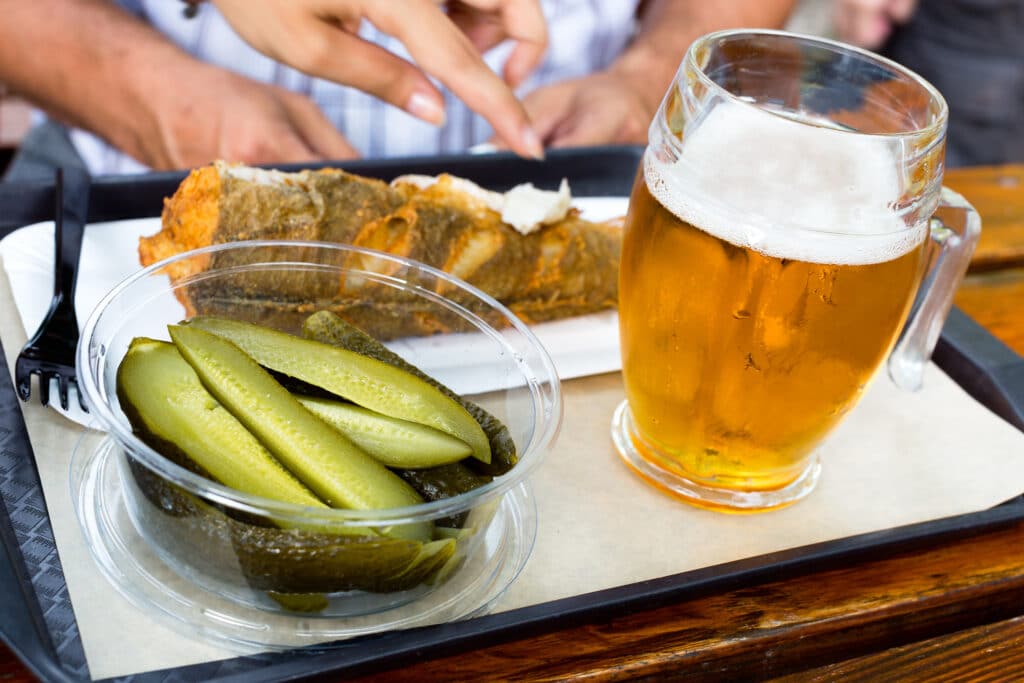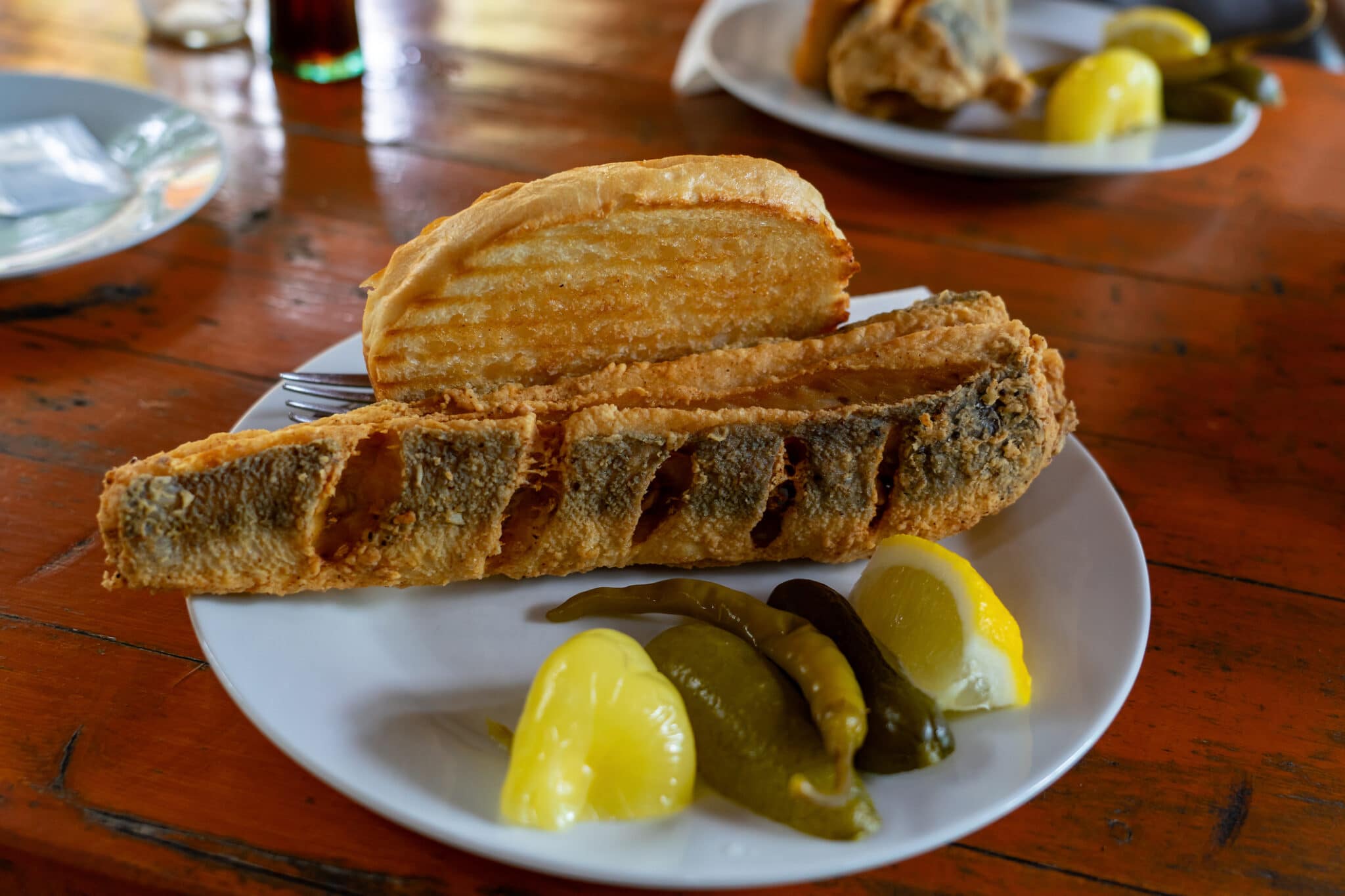Hekk: Hungary’s Favorite Saltwater Fish
One of the surest signs of summer in Budapest is when locals head for the promenade on Római Part and enjoy a bite of hekk, or hake, in the outdoor weather, sunning themselves on deck chairs and sipping beer on the banks of the Danube in northern Buda. Though this one-time workers’ getaway is being slowly dismantled and developed for more profitable use, it is still the best place to eat hekk, unless you want to beat a path all the way to the shores of Lake Balaton, which also has a strong summer hekk eating tradition.
Hekk is a curious fish to find in Hungary, as it is a sea fish, and Hungary is a landlocked country. How hekk became so popular locally is still a bit murky. Some hold that its import is due to the diminishing quantity of fogas (pike-perch) in Lake Balaton, while other maintain the nostalgic love of hekk extends back to when Hungary had its borders on the sea. No matter what the reason, Hungarians eat a lot of hekk in the summer, and while it is not as popular in the winter, it is certainly available at fish restaurants and lunch canteens around Budapest.

Eaten on paper or plastic, with a few csemege uborka (gherkins), a slice of white bread, mayo or tartar sauce, and usually with a side of fries, it’s tempting to call hekk the Hungarian version of fish and chips. This isn’t quite accurate though, as hekk is somewhat spicier, because the fish is rubbed with paprika before battered and put in the deep frier.
Lots of people will swear there is a ‘best’ place to eat hekk. But in truth, there is a sameness to much of the local hekk. It’s all frozen fish, deep fried, and basically of unknown origin. What a plate of hekk benefits from is the environment in which it is eaten. True, you can lunch on hekk in winter but hekk is really a summer food. Ideally, it is eaten next to a body of water, giving you the illusion that it is a Hungarian fish, despite the fact that it is shipped hundreds, if not thousands, of kilometers from its source. And, for the record, its original source is Argentina, according to hazipatika.com, though the fish are caught in places from the Mediterranean to the north Atlantic.
In the cod family, hekk is a flakey white fish with a very subtle taste. The steel gray skin is left on when served, and adds texture and flavor to the otherwise blank canvas that is most white fish. According to the BBC, “In France, hake is called ‘saumon blanc’ (which translates as ‘white salmon’) while in the United States it’s known as ling or whiting (what is known as whiting in Europe is a different, less tasty fish).” In other words, it’s not a delicate fish, but rather food for the masses.
One of the endearing aspects of eating hekk is that it is frequently served without utensils. The thick chunks of meat are easily plucked from the bone, leaving the diner to go through a pile of napkins or discreetly lick their fingers.
So, in the end, we have a fish that is not from Hungary, but the Hungarian way to eat it is next a body of Hungarian water. Don’t let that contradiction keep you from enjoying this summer tradition, best achieved at Római Part, while it lasts.
source (article; video and picture): Taste Hungary; Sült hekk recept, Cookpad receptek, Youtube
A cikk elolvasása után válaszolj a következő kérdésekre.
- What sign summer in Budapest?
- What is the difference between Hungarian fried hekk and fish and chips?
- What is common in local hekk in Hungary?
- Why is it important to leave the skin on when hekk is served?
- Why is it enjoyable to eat hekk?
keys/megoldások:
1. Locals when they head for the promenade on Római Part and enjoy a bite of hekk, or hake, sun themselves on deck chairs and sip beer on the banks of the Danube in northern Buda.;
2. Hekk is spicier, because the fish is rubbed with paprika before battered and put in the deep frier.;
3. It’s all frozen fish, deep fried, and basically of unknown origin.;
4. It adds texture and flavor to the white fish.;
5. Because you can eat it without utensils when they are not served, using your fingers and loads of/ a pile of napkins. you can also discreetly lick your fingers as well.
Vocabulary
| promenade | sétány |
| to sun | napozni/sütkérezni a napon |
| deck chairs | nyugágyak |
| to sip | kortyolgatni |
| getaway | menekülés |
| to dismantle | lerombolni |
| to beat a path | utat törni/kitaposni az utat |
| landlocked | tenger nélküli/tengerrel nem határos |
| murky | homályos |
| due to | valami miatt |
| diminishing | csökkenő |
| to extend back to | visszanyúlni |
| available | elérhető |
| tempting | csábító |
| accurate | pontos |
| to be rubbed | be van dörzsölve |
| to swear | esküdni |
| sameness | azonosság |
| a plate of | egy tányérnyi |
| to benefit from | profitálni |
| to a body of water | állóvíz |
| despite the fact | valamilyen tény ellenére |
| source | forrás |
| cod | tőkehal |
| flakey | pikkelyes |
| subtle | finom/kifinomult |
| ling | nyelvhal |
| whiting | sárga tőkehal/ vékonybajszú tőkehal |
| the masses | a nagy tömegeknek |
| endearing | szeretetreméltó |
| utensils | evőeszközök |
| chunks | nagyobb darabok |
| to pluck | lehúzni/lefejteni |
| to go through a pile of napkins | elhasználni egy halomnyi szalvétát |
| to lick | nyalogatni |
| contradiction | ellentmondás |
| to achieve | elérni |
| to last | valameddig tartani |






